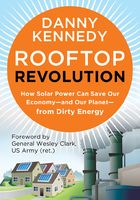
CHAPTER 1 Sunny Side Up
Now, here, you see, it takes all the running you can do, to keep in the same place. If you want to get somewhere else, you must run at least twice as fast as that!
—LEWIS CARROLL, FROM THROUGH THE LOOKING GLASS
SOLAR IS DEAD—AT LEAST THAT’S WHAT ITS DETRACTORS want you to believe. Dead in the water, they say, dead as disco and dinosaurs, a hippie-dippy pipe dream gone up in smoke. But these solar-energy opponents, many of whom hail from the coal, oil, nuke, and gas lobbies (ol’ King CONG), have recently been pointing to just one example in their efforts to prove their point: Solyndra, the erstwhile solar-industry poster child, which, in 2011, made headlines and drew nationwide derision when it went bankrupt after receiving a $500 million loan from the US government.
But here’s the truth King CONG doesn’t want you to know: The downfall of Solyndra actually proved that solar power is fast becoming the most cost-effective and efficient form of electricity on Earth. The company’s failure was largely due to competition in a market that’s been growing at an amazing rate, and Solyndra’s idea for a lower-cost solar module (which had a daft cylindrical design that was too fragile and too expensive to make) simply couldn’t compete with less-expensive, mass-produced silicon-based solar panels, the cheapest of which largely come from China—not an uncommon practice as new products become more common and affordable.
Solar-panel manufacturing is relatively simple (it’s less complex than, say, making a car), and a lot of it can be done using automated methods or low-skilled labor, of which China has plenty.
Let’s look at Apple Inc. for a moment. Here’s a company that designs its devices in California and then sells them through clever online and physical retail stores around the world, but it manufactures these products in Chinese factories. The world loves Apple products, and Wall Street loves the company, which in 2012 surpassed Exxon as the most valuable in the world. It currently has more cash than the US government! There are problems aplenty with this model of manufacturing, and I’m not naïve about the issues—such as labor conditions for the factory workers and environmental impacts like the pollution caused by poor regulation—but let’s be realistic: Apple is traveling a well-worn path, following such companies as Dell and General Electric. That path leads to great opportunity in ancillary businesses—the benefits created by Apple in creativity, publishing, recording, telephony, and sales of its various devices are legend—and the greater good, which is the availability of Apple’s amazing products.
The truth is, we should be glad that China is making solar panels cheaply—it makes these products more affordable for Americans and the billion-plus people on the planet who don’t currently get electricity and would otherwise turn to dirty planet-cooking coal, oil, or gas to get it. Though domestic manufacturing of solar panels and solar-panel parts is gaining strength in America over the first decade of the twenty-first century, the real jobs and margins right now are elsewhere in the industry—in sales, marketing, finance, and the installation of these products. Most of the jobs are downstream.
So Solyndra went bust, which is sad for the people who worked there, but its demise in no way marks the end of an entire industry. Nevertheless many people who had turned a blind eye to government pork for bad ideas and bankruptcies waiting to happen, and those who had sought federal funding for all sorts of less-worthy ventures, like a bridge in Alaska that went nowhere, had a field day. There was a frenzy of media coverage fed by political hearings and witch hunts that made this one company’s fate one of the biggest stories of the year. Indeed, the hysteria surrounding Solyndra’s bankruptcy reminds me of the people who thought that the fall of the web browser Netscape marked the end of the Internet. More column inches were devoted to the Solyndra story in most outlets than to Japan’s Fukushima nuclear-power-plant disaster, which wrote down the Tokyo Electric Power Company’s value by $13 billion and required a $9 billion bailout by the people of Japan.
But why has the so-called demise of solar energy and the solar industry been so widely reported? Because the rise of solar power is a direct threat to the rich and powerful corporations that create electricity through dirty, unsustainable, and harmful fossil fuel.